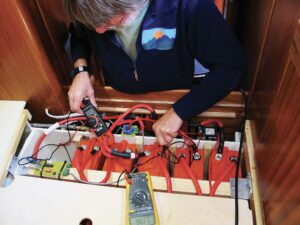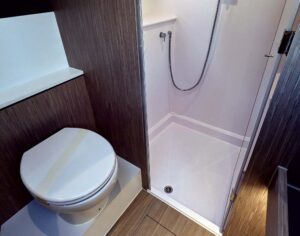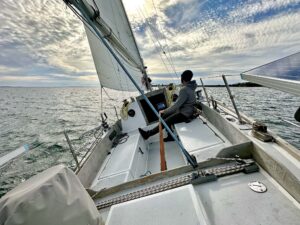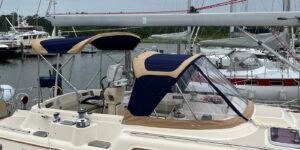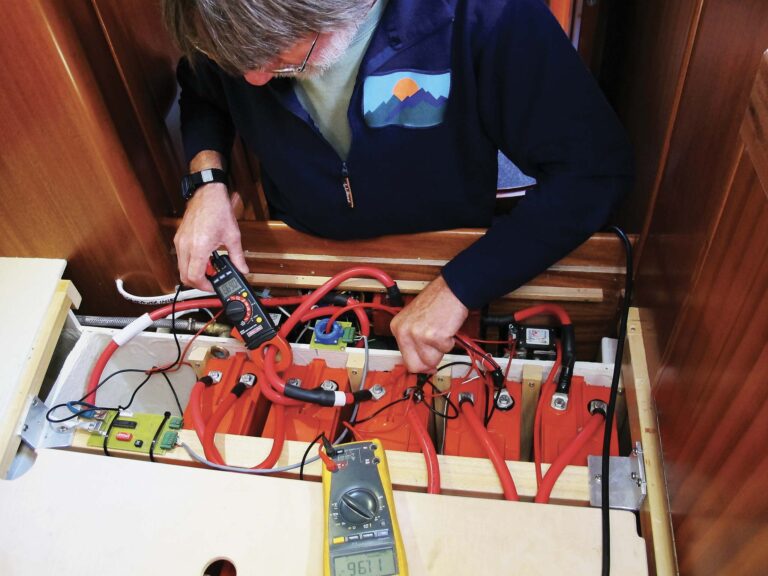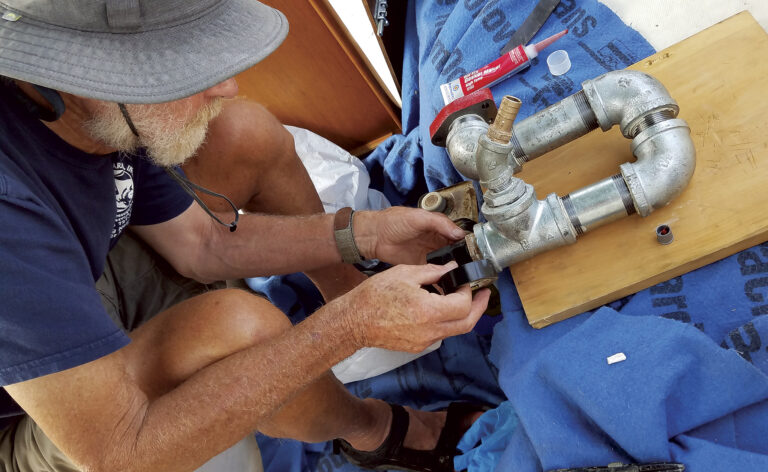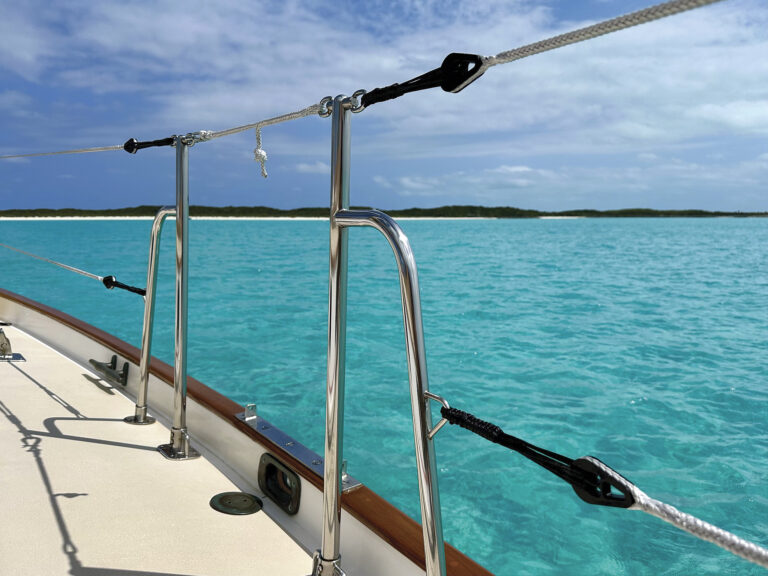
With solid-state inverters and domestic AC devices becoming increasingly efficient, it only makes sense for many sailors to install the necessary 120V AC power for the many appliances now finding their way onboard: including washing machines, TVs, microwave, laptops, chargers for phones and tablets, and even AC fridges and cookers. At one time a sailboat fitted with the necessary gear would probably have been 100ft in length and have a 10kW generator deep in its bowels, but not anymore.
Modern efficiency
Modern combination inverter/chargers, as opposed to those same separate devices available for some years now, are built to function as both a multi-stage battery charger and sine-wave inverter in a single box. To this end, they have an AC input that can be connected to dock power or a generator for topping off your batteries, and at least one AC outlet (and often more).
Almost all modern inverters provide a pure sine-wave AC output similar to (and sometimes better than) that found on the domestic grid, to ensure compatibility with all common household appliances, no matter how sensitive.
The more sophisticated models can also detect when shore power or a generator is connected, switching back and forth between invert and charge mode in a matter of milliseconds. This, in turn, provides an Uninterrupted Power Supply (UPS) that allows devices such as PCs to continue operating without forever re-booting.
When connected to shore power and charging, many combis will also provide direct AC to the vessel’s mains outlets at the same time. The top models can even automatically adjust the DC battery charge rate to suit the AC demand, reducing it when more is needed at the outlets. Others simply offer a fixed or pre-programmable maximum DC charge rate instead.
While some combis insist on a clean and constant waveform when accepting AC power from an onboard generator, the smarter devices simply adjust the incoming power to compensate. None, however, permit both a generator and the grid to be connected and running simultaneously. Though possible in theory, it would require their waveforms to be precisely synchronized using some very complex (read expensive) circuitry.
Volt-Amps or Watts?

The power output of an AC circuit is sometimes stated in Volt Amps (VA) rather than the more commonly used Watts (W). According to Ohm’s Law the two should be identical (V x A = W). However, in practice, there is a slight difference that depends on the electrical efficiency of the device called its Power Factor (PF). Wattage, therefore, is the more realistic figure as it is derived from the actual current and voltage supplied after PF corrections are taken into account. Wattage also makes it easier to calculate the size inverter you require. As you are doing so, be sure to also consider an inverter’s surge rating as well as any heavy loads demanding extra power on startup. Some combis offer a brief 5-second boost, others up to 30 seconds. Seek out the latter if you have a particular device that requires a long boost when first powered on.
When operating, the inverter itself often uses between 2 and 5 amps, which must be added to any consumption calculations being made at the system planning stage. Combis also consume power when idle, though many now also incorporate a power-save (PS) function that regularly checks the output for any load, leaving the device in standby if none is detected. In operation, this can cause a short pause between plugging in a device and the combi sensing the load and powering up. However, it is worth it for the long-term energy savings that result.
Typical power drain in PS mode is about 200mA. It also usually requires a load above 30 watts to fully activate the inverter. As a result, if you wish to run very small loads, such as a phone charger, you will need to override the PS mode or only use it when the inverter is already running another, larger load. Another option is to buy a smaller inverter, say 300 watts, for low-power loads, leaving the bigger one for your more heavy-duty devices.
Although most good-quality combis will have a low-voltage alarm that is either tagged to a preset voltage (usually 10.5V) or user-programmable, only some offer a low-voltage disconnect function. For those that don’t, it’s advisable to add a “battery saver” to the DC circuit to protect your batteries from running completely flat.
Some less sophisticated combis without this feature will also allow you to put them into charge-only mode instead, so that should shore power become disconnected when you’re away from the boat, it won’t automatically switch over to the inverter and destroy your batteries. Of course, this is clearly of no use if you want to leave, say, an AC fridge on low while you’re away.
In terms of output, the latest combis now provide two separate AC output circuits: one for general use via the boat’s ring main; a second purely for running high-power devices, such as washing machines, immersion heaters and air conditioning, devices that you would only ever want to use when connected to shore power or with the generator on. In the event either goes down, this high-power outlet is automatically switched off.
Finally, there is the boost, or power assist, function, which allows the AC output current to be boosted by the inverter if there is not enough current available at the shore power/generator connection. The point at which this is automatically enabled can be fixed in the setup mode and adjusted to suit your specific generator or shore power supply.
Power assist can be particularly useful when, say, running a device off the generator that just needs the occasional boost to get going, like fridges, washing machines or heavy power. Some of the more advanced combis can also be linked in parallel or series to another identical combi to supply even more power. Special circuitry is required to ensure their outputs remain accurately synchronized, though, so only devices offering this feature are compatible.
Wiring
In terms of wiring, today’s AC combi inverters are designed to be your primary connection to shore power, and though many contain circuit breakers to protect the device itself, their AC output must still be fed through a proper AC consumer distribution box with suitable circuit breakers to protect the end user: exactly as a domestic AC supply would be.
Beyond that, it is important to realize that inverters consume a great deal of battery power when on. As a rough guide to current draw, take the AC wattage rating of a device, divide it by 12 and add 10 percent for inefficiencies, like heat loss and voltage drop. As an example, a 1kW inverter could draw around 92 amps from your battery bank, meaning a full and continuous 1kW load would take a 360Ah (amp hour) battery bank down from fully charged to 50 percent capacity (the point below which you really must avoid discharging) in just two hours.
Equally important, with these levels of DC current flowing, you really must ensure the wiring to the battery is correctly sized (AWG 2/0 minimum for a 2.5kW combi) and as short as possible (preferably less than 3ft from battery to combi). The DC supply must also be protected with the recommended fuse (usually between 250 and 400 amps) mounted as close to the positive battery terminal as possible.
What follows is a list of some of the primary brands of combis currently on the market.
Victron MultiPlus
One of the best known and respected brands of marine power products now on the market, these are ruggedly built with a wide range of sophisticated features, including:
• Dual AC outputs for high (when connected to the grid or generator) and regular loads.
• Power Control, which limits the maximum input current, only using what remains for charging after other AC loads are accounted for.
• Power Assist, which allows battery supplementation of an AC source where peak power is required for a limited period. When the load is reduced any spare power is again used recharging.
• The ability to connect six MultisPlus units in parallel to achieve a higher power output.
• On-site monitoring and control via the Battery Monitor, Multi Control Panel, Ve.Net Blue Power Panel, Color Control Panel, smartphone or tablet (Bluetooth) or PC (USB or RS232).
• Remote monitoring and control via Victron Ethernet Remote, Venus GX, Color Control Panel and on the VRM website.

Mastervolt Mass Combi
Nearly as well-known as Victron and equally well made in Europe, the systems include most of the “smart” features and are:
• Compact, lightweight and silent.
• Intelligent 3-step battery charger.
• Able to charge two individual battery banks simultaneously.
• Capable of producing 200% peak power briefly to overcome starting surges.
• Able to get assistance from the batteries when grid or generator power is limited.
• Able to provide a pure sine wave AC output that prevents damage to sensitive equipment.
• Equipped with dual AC outputs to separate critical equipment from heavy loads.
• Capable of producing higher yields via parallel switching (2500W models).
• Compatible with MasterBus network monitors and controllers.

Promariner/TruePower
Another well-known make of marine charger/inverter with a reputation for good performance and reliability, these systems offer:
• Pure sine wave AC output.
• Current limiting with a built-in monitor for vital functions and damage prevention.
• Remote control for locally mounted status and control panel.
• Automatic 30A AC transfer switch to ensure AC power is continuously available.
• An automatic three-stage charger with seven charge profiles for different battery types.
• Up to 2.8 times inverter surge capacity for high start current appliances.
• Automatic overload, low and high battery, over-current and overheat protection with audible fault alarms and LED status indicators.
Sterling Pro Combi
A well-known brand with all the basics but few frills. Sterling believes in keeping it simple so there’s less to go wrong. Features include:
• Pure sinewave AC output.
• Easy installation and setup.
• Low quiescent current.
• A Power Save mode that reduces standby current to 200mA.
• 30A through current for AC grid or generator.
• A grid to inverter changeover period of just 20m/s for continuous operation.
• Automatic Power Factor correction.
• A removable, hard-wired remote-control panel supplied with 10m cable.
• Intelligent four-step progressive charging for eight different battery types.
• A charger-only option to avoid battery drain in the event of grid failure.
Xantrex Freedom
A ruggedly built range of combis designed specifically for mobile use and featuring a wide range of advanced functions, including:
• Built-in AC transfer switch between inverter and incoming AC power.
• Generator Support Mode (Boost).
• Parallel and series stacking capabilities.
• A multi-stage, temperature compensated 12/24V battery charger.
• Coated circuit boards for humid environments.
• Ignition lockout feature.
• Automatic overload, short-circuit, over/under voltage protection.
• Integrated, resettable AC breakers.
OutBack
The American made Outback range of sealed and vented combis are specifically designed for harsh environments typically found at sea and boast many of the latest technically advanced features, such as:

• Built-in AC transfer switching between inverter and incoming AC.
• A modular networked system allowing several to be connected together in parallel or series.
• A fast AC transfer switch time of 16ms.
• Up to 93 percent efficiency.
• A die-cast aluminum casing that helps prevent corrosion.
• Sealed models with coated PCBs also available for damp environments.
Unknown brands
As we all know there are a plethora of electronic goods available online, but how safe they are is not always easy to evaluate without long-term testing in a marine environment. Personally, I wouldn’t take what’s on the label for gospel truth and would err on the safe side of power limits, cable sizes and circuit protection. While there are plenty of quite reasonable makes of Asian-built electrical gear, not all can be relied upon to perform within their quoted specs. If in doubt, heed the old adage “if it looks too good (or cheap) to be true, it usually is!”

Modified or Pure sinewave output?
Don’t be fooled by the expression “sine-wave’ inverters.” If they don’t clearly state they have a “pure” or “true” sinewave (PSW) output, it’s more than likely they’ll be a “modified” (MSW), or “quasi” sinewave. An MSW produces a modified square wave with a sharp drop off, unlike the gently undulating pure sinewave AC curve.
Generally, most domestic electrical goods, like microwaves and washing machines, can be run off either waveform, but there are a few exceptions. If in doubt, either select a smaller PSW inverter for your sensitive devices and an MSW for the rest or choose a PSW for everything AC and expect to pay around 15-25 percent more.
Poorly built combis of any type can also emit a lot of RF interference, so keep them at least 3ft away from any radio antennae, including GNSS/GPS
RESOURCES
Mastervolt mastervolt.com
Outback Power outbackpower.com
ProMariner LLC promariner.com
Sterling Power sterling-power-usa.com
Victron Energy victronenergy.com
Xantrex xantrex.com
October 2019

